2013 NISSAN PATHFINDER belt
[x] Cancel search: beltPage 1 of 19
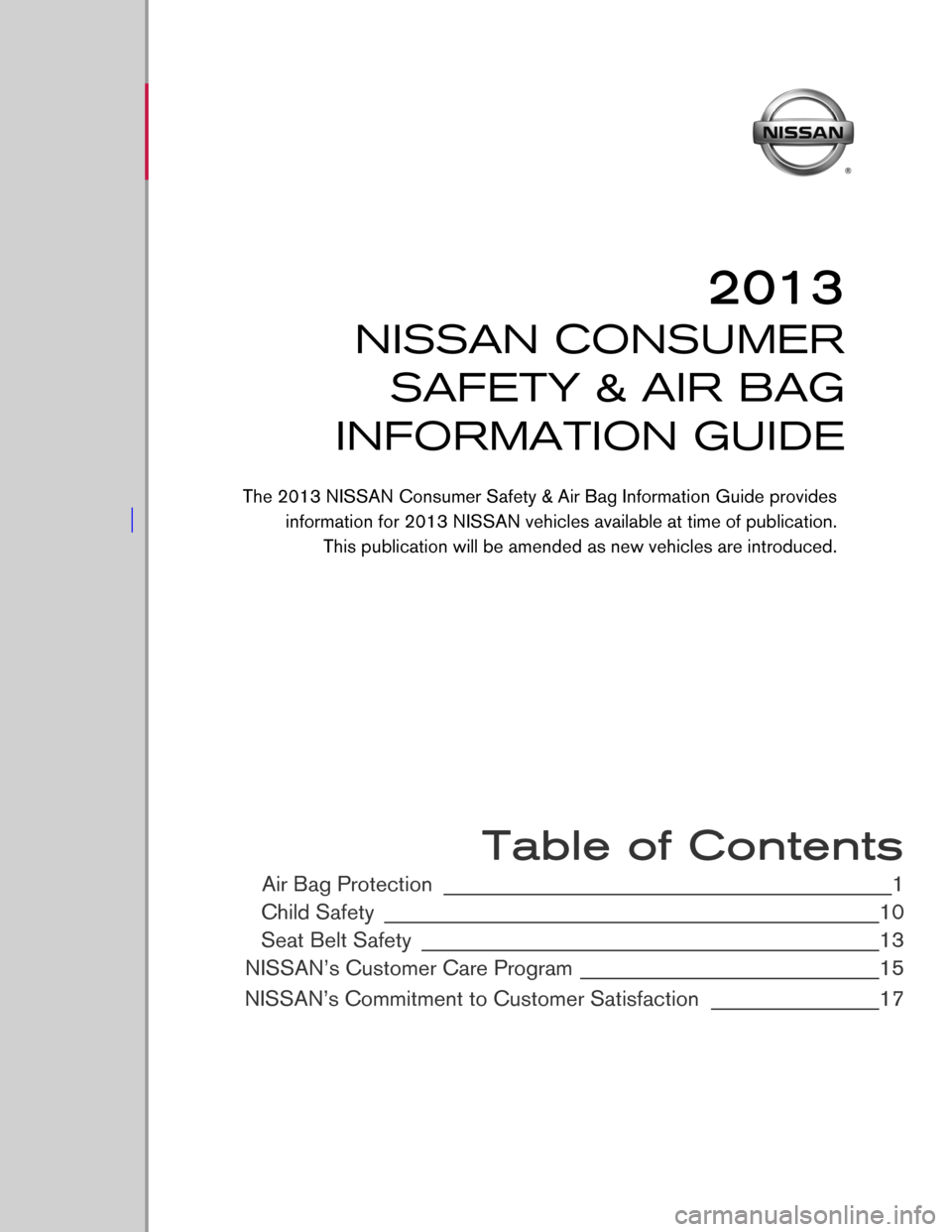
Table of Contents
Air Bag Protection ________________________________________________1
Child Safety
_____________________________________________________10
Seat Belt Safety
_________________________________________________13
NISSAN’s Customer Care Program
________________________________15
NISSAN’s Commitment to Customer Satisfaction __________________17
2013
NISSAN CONSUMER
SAFETY & AIR BAG
INFORMATION GUIDE
The 2013 NISSAN Consumer Safety & Air Bag Information Guide provides
information for 2013 NISSAN vehicles available at time of publication.
This publication will be amended as new vehicles are introduced.
Page 2 of 19
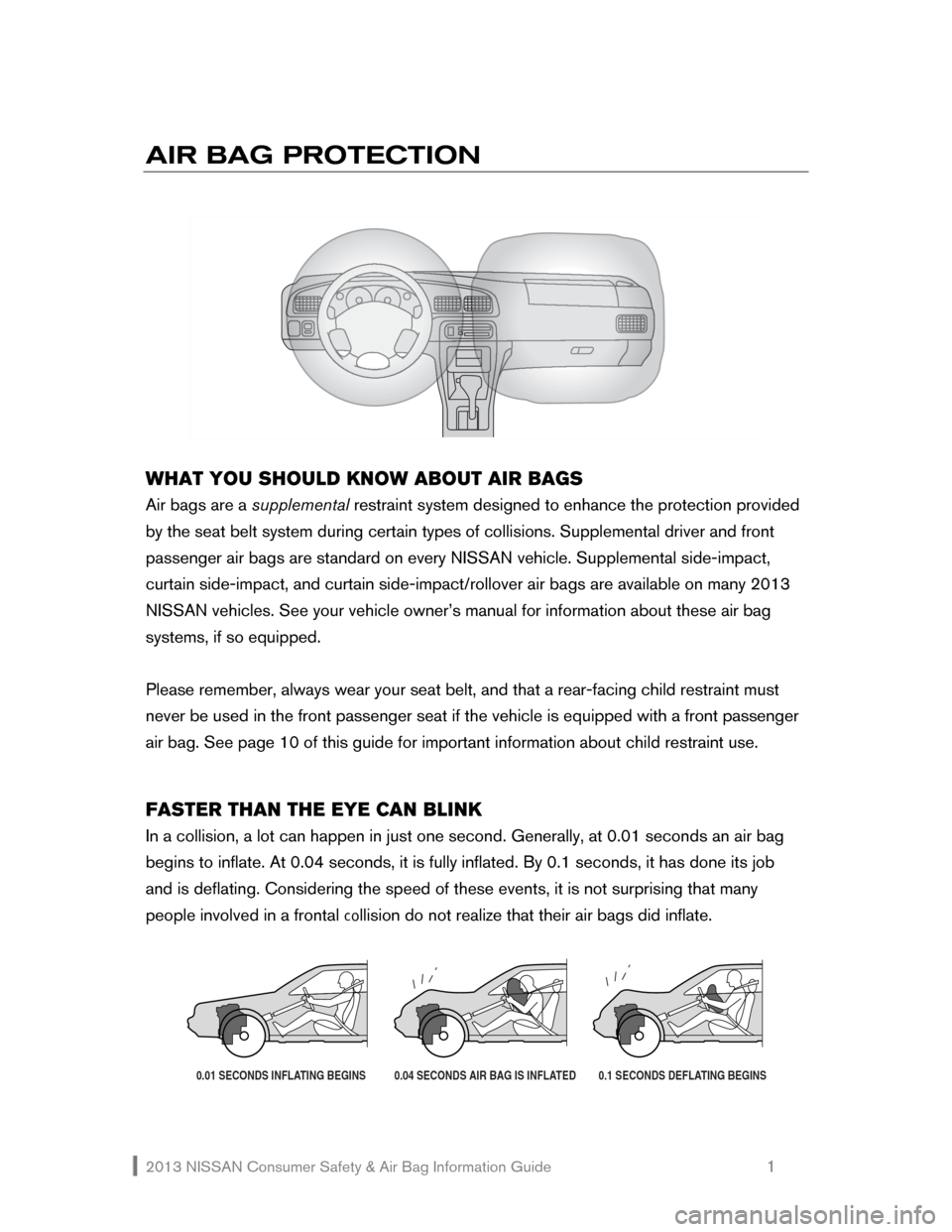
2013 NISSAN Consumer Safety & Air Bag Information Guide 1
AIR BAG PROTECTION
WHAT YOU SHOULD KNOW ABOUT AIR BAGS
Air bags are a supplemental restraint system designed to enhance the protection provided
by the seat belt system during certain types of collisions. Supplemental driver and front
passenger air bags are standard on every NISSAN vehicle. Supplemental side-impact,
curtain side-impact, and curtain side-impact/rollover air bags are available on many 2013
NISSAN vehicles. See your vehicle owner’s manual for information about these air bag
systems, if so equipped.
Please remember, always wear your seat belt, and that a rear-facing child restraint must
never be used in the front passenger seat if the vehicle is equipped with a front passenger
air bag. See page 10 of this guide for important information about child restraint use.
FASTER THAN THE EYE CAN BLINK
In a collision, a lot can happen in just one second. Generally, at 0.01 seconds an air bag
begins to inflate. At 0.04 seconds, it is fully inflated. By 0.1 seconds, it has done its job
and is deflating. Considering the speed of these events, it is not surprising that many
people involved in a frontal
collision do not realize that their air bags did inflate.
0.01 SECONDS INFLATING BEGINS 0.04 SECONDS AIR BAG IS INFLATED 0.1 SECONDS DEFLATING BEGINS
Page 3 of 19
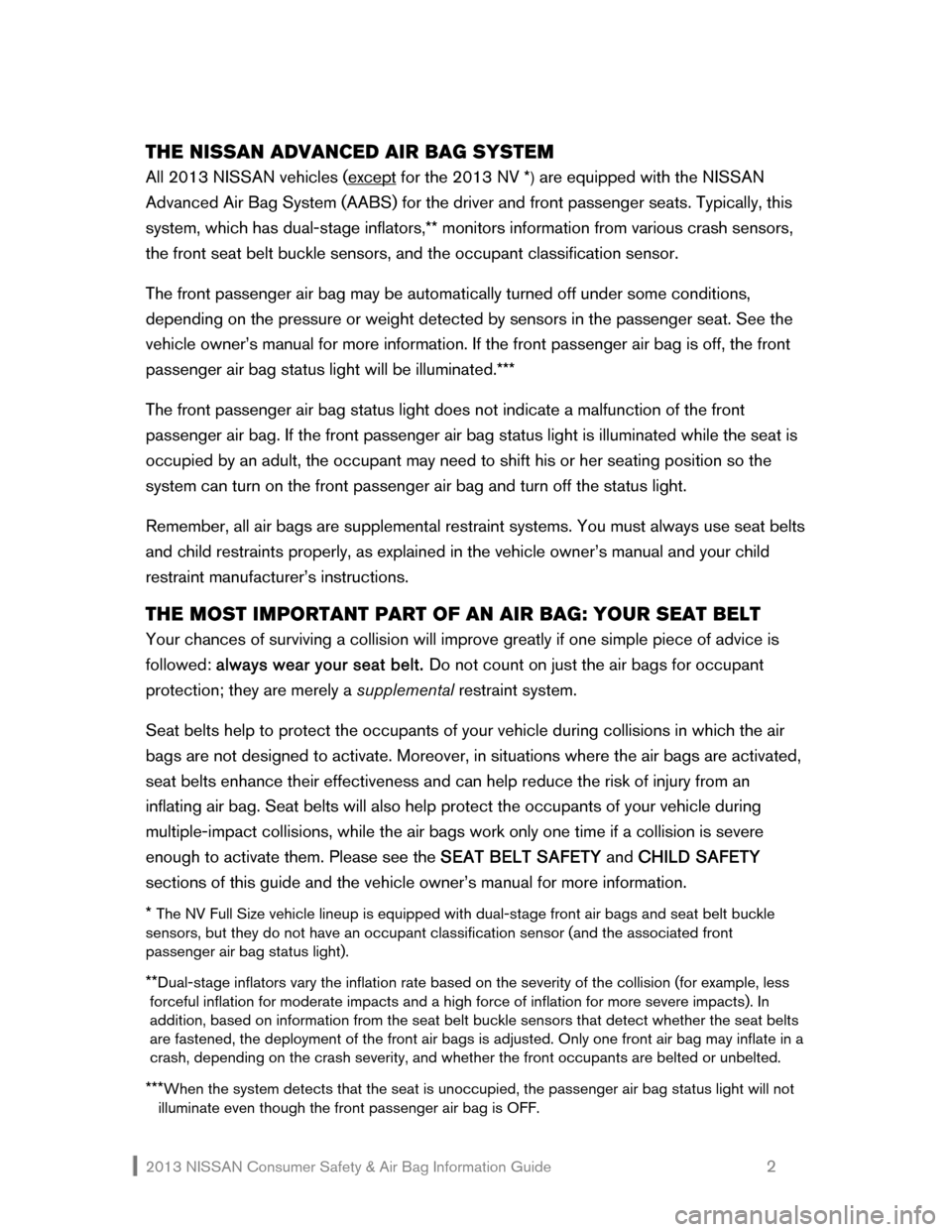
2013 NISSAN Consumer Safety & Air Bag Information Guide 2
THE NISSAN ADVANCED AIR BAG SYSTEM
All 2013 NISSAN vehicles (except for the 2013 NV *) are equipped with the NISSAN
Advanced Air Bag System (AABS) for the driver and front passenger seats. Typically, this
system, which has dual-stage inflators,** monitors information from various crash sensors,
the front seat belt buckle sensors, and the occupant classification sensor.
The front passenger air bag may be automatically turned off under some conditions,
depending on the pressure or weight detected by sensors in the passenger seat. See the
vehicle owner’s manual for more information. If the front passenger air bag is off, the front
passenger air bag status light will be illuminated.***
The front passenger air bag status light does not indicate a malfunction of the front
passenger air bag. If the front passenger air bag status light is illuminated while the seat is
occupied by an adult, the occupant may need to shift his or her seating position so the
system can turn on the front passenger air bag and turn off the status light.
Remember, all air bags are supplemental restraint systems. You must always use seat belts
and child restraints properly, as explained in the vehicle owner’s manual and your child
restraint manufacturer’s instructions.
THE MOST IMPORTANT PART OF AN AIR BAG: YOUR SEAT BELT
Your chances of surviving a collision will improve greatly if one simple piece of advice is
followed: always wear your seat belt. Do not count on just the air bags for occupant
protection; they are merely a supplemental restraint system.
Seat belts help to protect the occupants of your vehicle during collisions in which the air
bags are not designed to activate. Moreover, in situations where the air bags are activated,
seat belts enhance their effectiveness and can help reduce the risk of injury from an
inflating air bag. Seat belts will also help protect the occupants of your vehicle during
multiple-impact collisions, while the air bags work only one time if a collision is severe
enough to activate them. Please see the SEAT BELT SAFETY and CHILD SAFETY
sections of this guide and the vehicle owner’s manual for more information.
* The NV Full Size vehicle lineup is equipped with dual-stage front air bags and seat belt buckle
sensors, but they do not have an occupant classification sensor (and the associated front
passenger air bag status light).
**Dual-stage inflators vary the inflation rate based on the severity of the collision (for example, less
forceful inflation for moderate impacts and a high force of inflation for more severe impacts). In
addition, based on information from the seat belt buckle sensors that detect whether the seat belts
are fastened, the deployment of the front air bags is adjusted. Only one front air bag may inflate in a
crash, depending on the crash severity, and whether the front occupants are belted or unbelted.
***When the system detects that the seat is unoccupied, the passenger air bag status light will not
illuminate even though the front passenger air bag is OFF.
Page 4 of 19
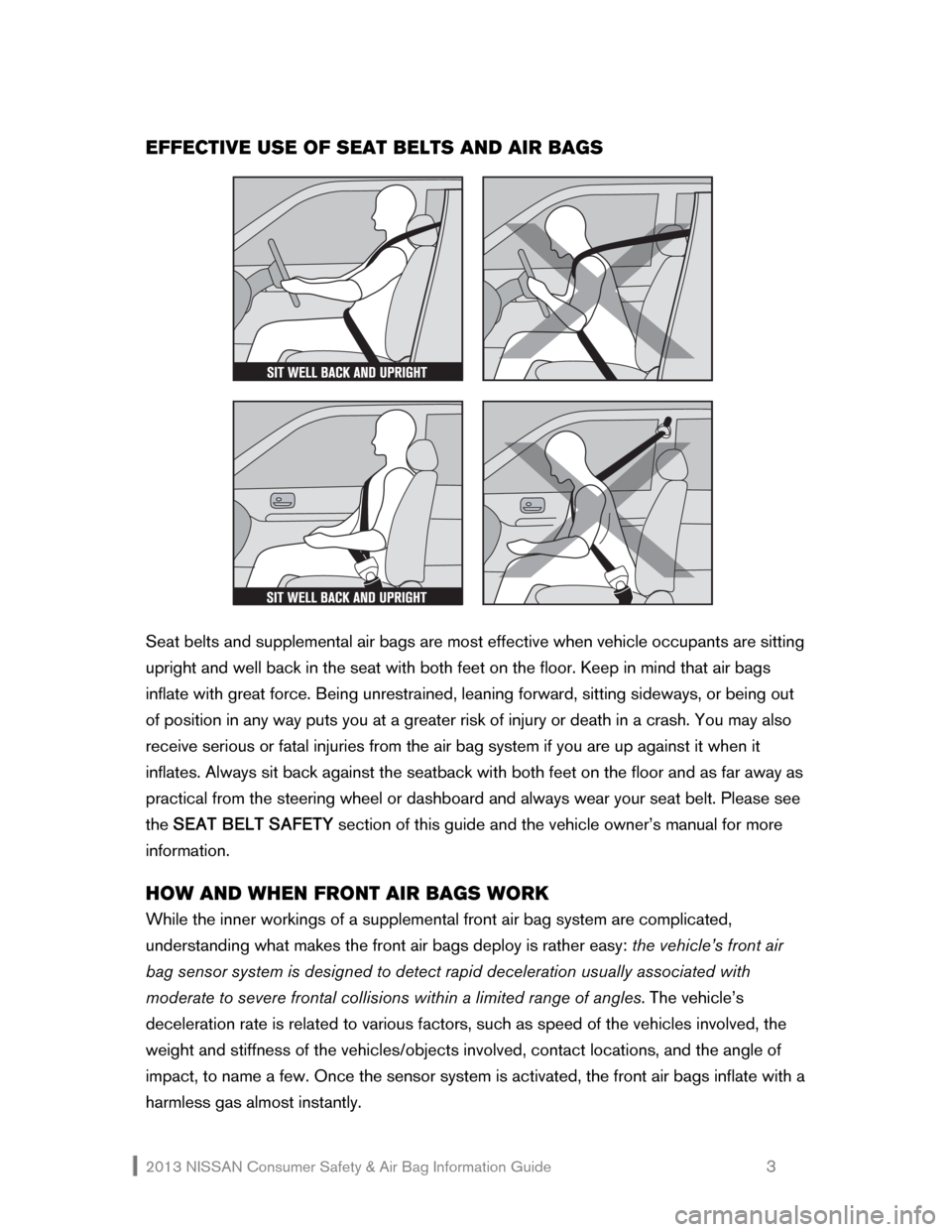
2013 NISSAN Consumer Safety & Air Bag Information Guide 3
EFFECTIVE USE OF SEAT BELTS AND AIR BAGS
Seat belts and supplemental air bags are most effective when vehicle occupants are sitting
upright and well back in the seat with both feet on the floor. Keep in mind that air bags
inflate with great force. Being unrestrained, leaning forward, sitting sideways, or being out
of position in any way puts you at a greater risk of injury or death in a crash. You may also
receive serious or fatal injuries from the air bag system if you are up against it when it
inflates. Always sit back against the seatback with both feet on the floor and as far away as
practical from the steering wheel or dashboard and always wear your seat belt. Please see
the SEAT BELT SAFETY section of this guide and the vehicle owner’s manual for more
information.
HOW AND WHEN FRONT AIR BAGS WORK
While the inner workings of a supplemental front air bag system are complicated,
understanding what makes the front air bags deploy is rather easy: the vehicle’s front air
bag sensor system is designed to detect rapid deceleration usually associated with
moderate to severe frontal collisions within a limited range of angles. The vehicle’s
deceleration rate is related to various factors, such as speed of the vehicles involved, the
weight and stiffness of the vehicles/objects involved, contact locations, and the angle of
impact, to name a few. Once the sensor system is activated, the front air bags inflate with a
harmless gas almost instantly.
Page 9 of 19
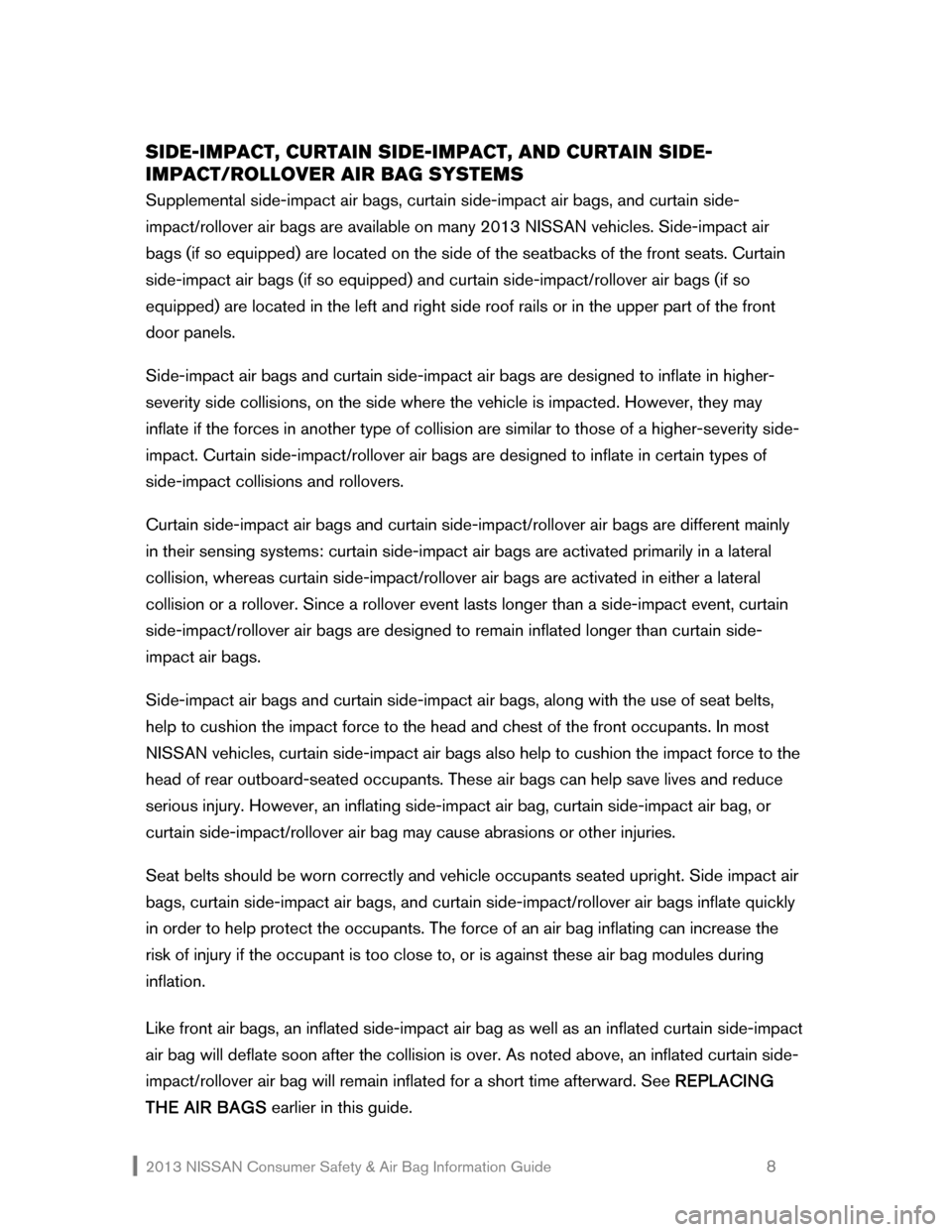
2013 NISSAN Consumer Safety & Air Bag Information Guide 8
SIDE-IMPACT, CURTAIN SIDE-IMPACT, AND CURTAIN SIDE-
IMPACT/ROLLOVER AIR BAG SYSTEMS
Supplemental side-impact air bags, curtain side-impact air bags, and curtain side-
impact/rollover air bags are available on many 2013 NISSAN vehicles. Side-impact air
bags (if so equipped) are located on the side of the seatbacks of the front seats. Curtain
side-impact air bags (if so equipped) and curtain side-impact/rollover air bags (if so
equipped) are located in the left and right side roof rails or in the upper part of the front
door panels.
Side-impact air bags and curtain side-impact air bags are designed to inflate in higher-
severity side collisions, on the side where the vehicle is impacted. However, they may
inflate if the forces in another type of collision are similar to those of a higher-severity side-
impact. Curtain side-impact/rollover air bags are designed to inflate in certain types of
side-impact collisions and rollovers.
Curtain side-impact air bags and curtain side-impact/rollover air bags are different mainly
in their sensing systems: curtain side-impact air bags are activated primarily in a lateral
collision, whereas curtain side-impact/rollover air bags are activated in either a lateral
collision or a rollover. Since a rollover event lasts longer than a side-impact event, curtain
side-impact/rollover air bags are designed to remain inflated longer than curtain side-
impact air bags.
Side-impact air bags and curtain side-impact air bags, along with the use of seat belts,
help to cushion the impact force to the head and chest of the front occupants. In most
NISSAN vehicles, curtain side-impact air bags also help to cushion the impact force to the
head of rear outboard-seated occupants. These air bags can help save lives and reduce
serious injury. However, an inflating side-impact air bag, curtain side-impact air bag, or
curtain side-impact/rollover air bag may cause abrasions or other injuries.
Seat belts should be worn correctly and vehicle occupants seated upright. Side impact air
bags, curtain side-impact air bags, and curtain side-impact/rollover air bags inflate quickly
in order to help protect the occupants. The force of an air bag inflating can increase the
risk of injury if the occupant is too close to, or is against these air bag modules during
inflation.
Like front air bags, an inflated side-impact air bag as well as an inflated curtain side-impact
air bag will deflate soon after the collision is over. As noted above, an inflated curtain side-
impact/rollover air bag will remain inflated for a short time afterward. See REPLACING
THE AIR BAGS earlier in this guide.
Page 11 of 19
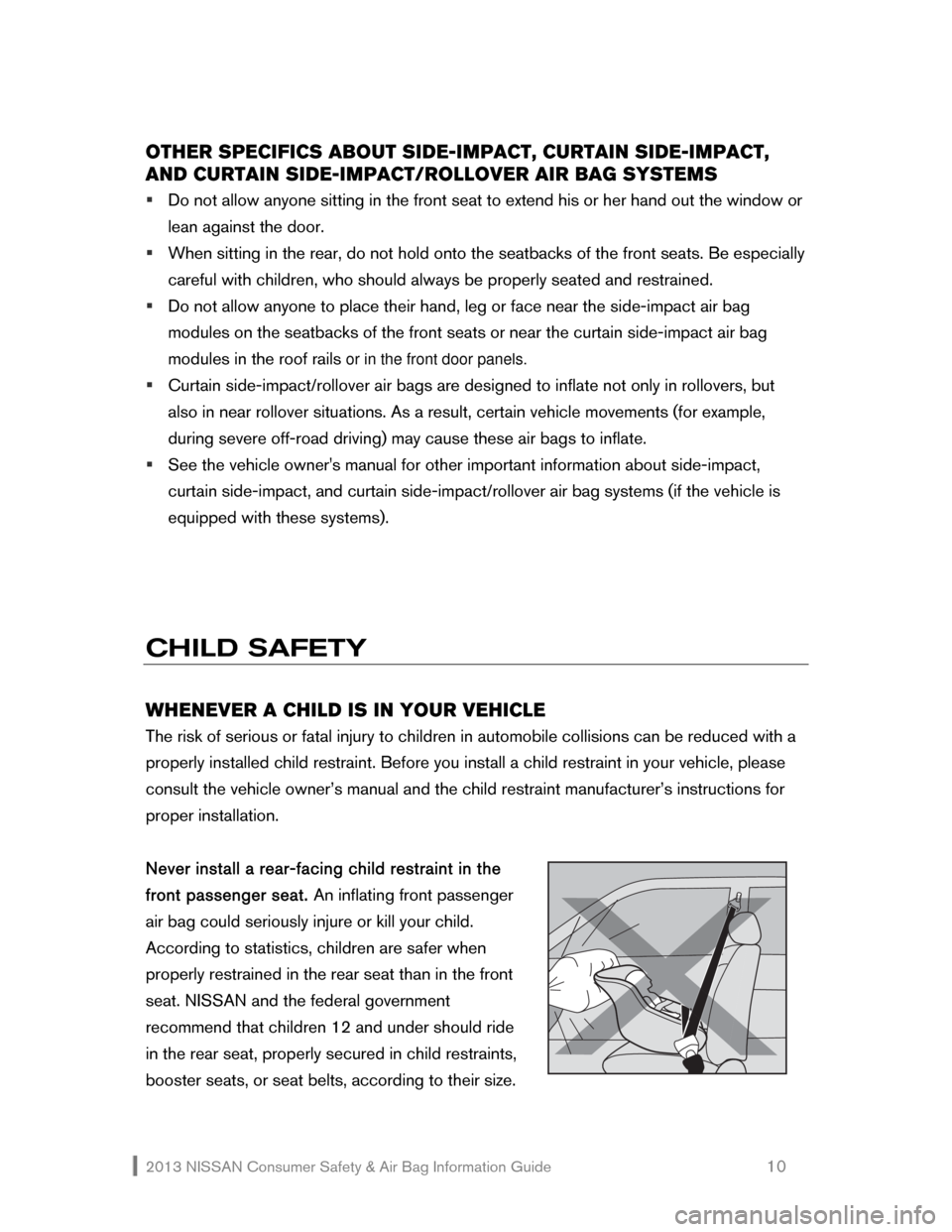
2013 NISSAN Consumer Safety & Air Bag Information Guide 10
OTHER SPECIFICS ABOUT SIDE-IMPACT, CURTAIN SIDE-IMPACT,
AND CURTAIN SIDE-IMPACT/ROLLOVER AIR BAG SYSTEMS
�ƒ Do not allow anyone sitting in the front seat to extend his or her hand out the window or
lean against the door.
�ƒ When sitting in the rear, do not hold onto the seatbacks of the front seats. Be especially
careful with children, who should always be properly seated and restrained.
�ƒ Do not allow anyone to place their hand, leg or face near the side-impact air bag
modules on the seatbacks of the front seats or near the curtain side-impact air bag
modules in the roof rails
or in the front door panels.
�ƒ Curtain side-impact/rollover air bags are designed to inflate not only in rollovers, but
also in near rollover situations. As a result, certain vehicle movements (for example,
during severe off-road driving) may cause these air bags to inflate.
�ƒ See the vehicle owner's manual for other important information about side-impact,
curtain side-impact, and curtain side-impact/rollover air bag systems (if the vehicle is
equipped with these systems).
CHILD SAFETY
WHENEVER A CHILD IS IN YOUR VEHICLE
The risk of serious or fatal injury to children in automobile collisions can be reduced with a
properly installed child restraint. Before you install a child restraint in your vehicle, please
consult the vehicle owner’s manual and the child restraint manufacturer’s instructions for
proper installation.
Never install a rear-facing child restraint in the
front passenger seat. An inflating front passenger
air bag could seriously injure or kill your child.
According to statistics, children are safer when
properly restrained in the rear seat than in the front
seat. NISSAN and the federal government
recommend that children 12 and under should ride
in the rear seat, properly secured in child restraints,
booster seats, or seat belts, according to their size.
Page 12 of 19
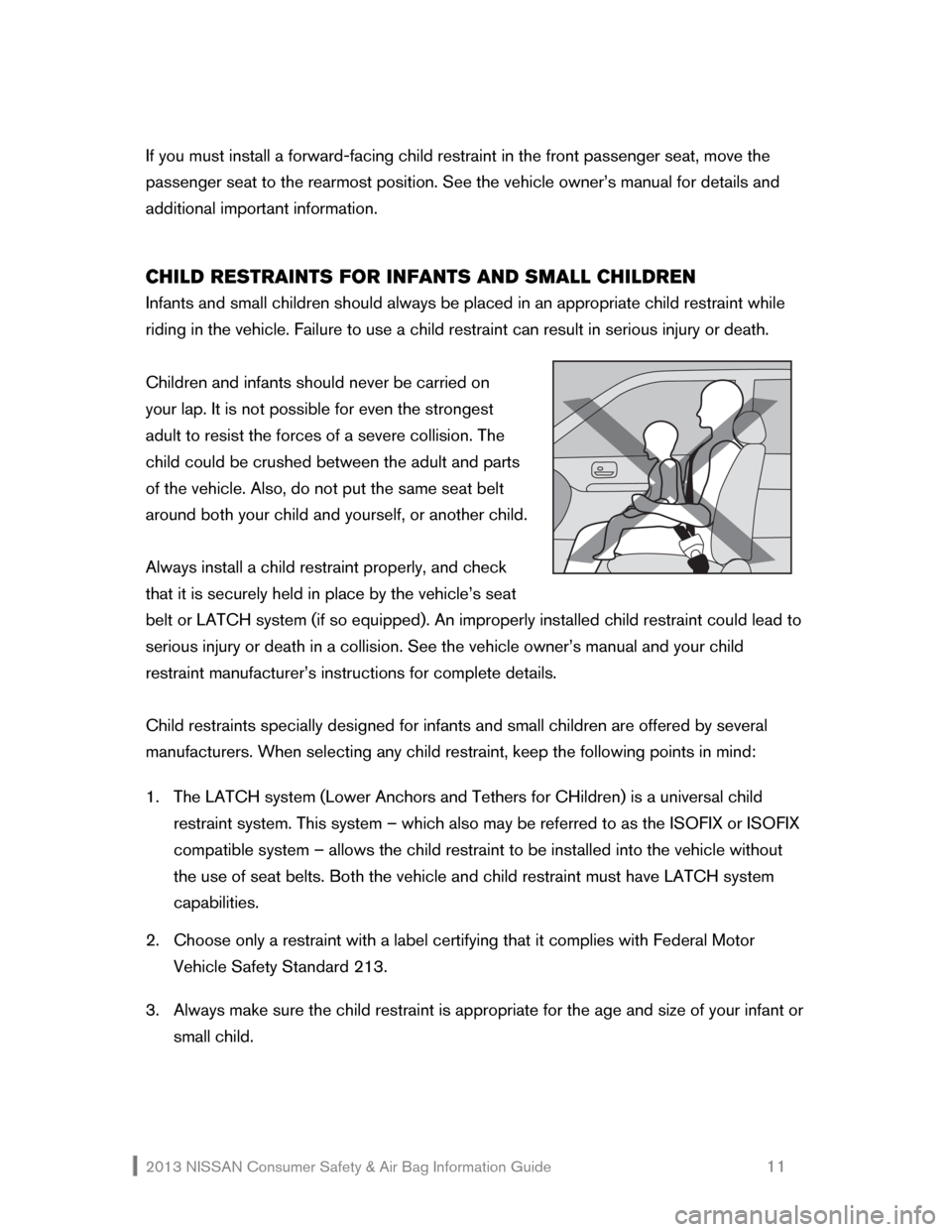
2013 NISSAN Consumer Safety & Air Bag Information Guide 11
If you must install a forward-facing child restraint in the front passenger seat, move the
passenger seat to the rearmost position. See the vehicle owner’s manual for details and
additional important information.
CHILD RESTRAINTS FOR INFANTS AND SMALL CHILDREN
Infants and small children should always be placed in an appropriate child restraint while
riding in the vehicle. Failure to use a child restraint can result in serious injury or death.
Children and infants should never be carried on
your lap. It is not possible for even the strongest
adult to resist the forces of a severe collision. The
child could be crushed between the adult and parts
of the vehicle. Also, do not put the same seat belt
around both your child and yourself, or another child.
Always install a child restraint properly, and check
that it is securely held in place by the vehicle’s seat
belt or LATCH system (if so equipped). An improperly installed child restraint could lead to
serious injury or death in a collision. See the vehicle owner’s manual and your child
restraint manufacturer’s instructions for complete details.
Child restraints specially designed for infants and small children are offered by several
manufacturers. When selecting any child restraint, keep the following points in mind:
1. The LATCH system (Lower Anchors and Tethers for CHildren) is a universal child
restraint system. This system – which also may be referred to as the ISOFIX or ISOFIX
compatible system – allows the child restraint to be installed into the vehicle without
the use of seat belts. Both the vehicle and child restraint must have LATCH system
capabilities.
2. Choose only a restraint with a label certifying that it complies with Federal Motor
Vehicle Safety Standard 213.
3. Always make sure the child restraint is appropriate for the age and size of your infant or
small child.
Page 13 of 19
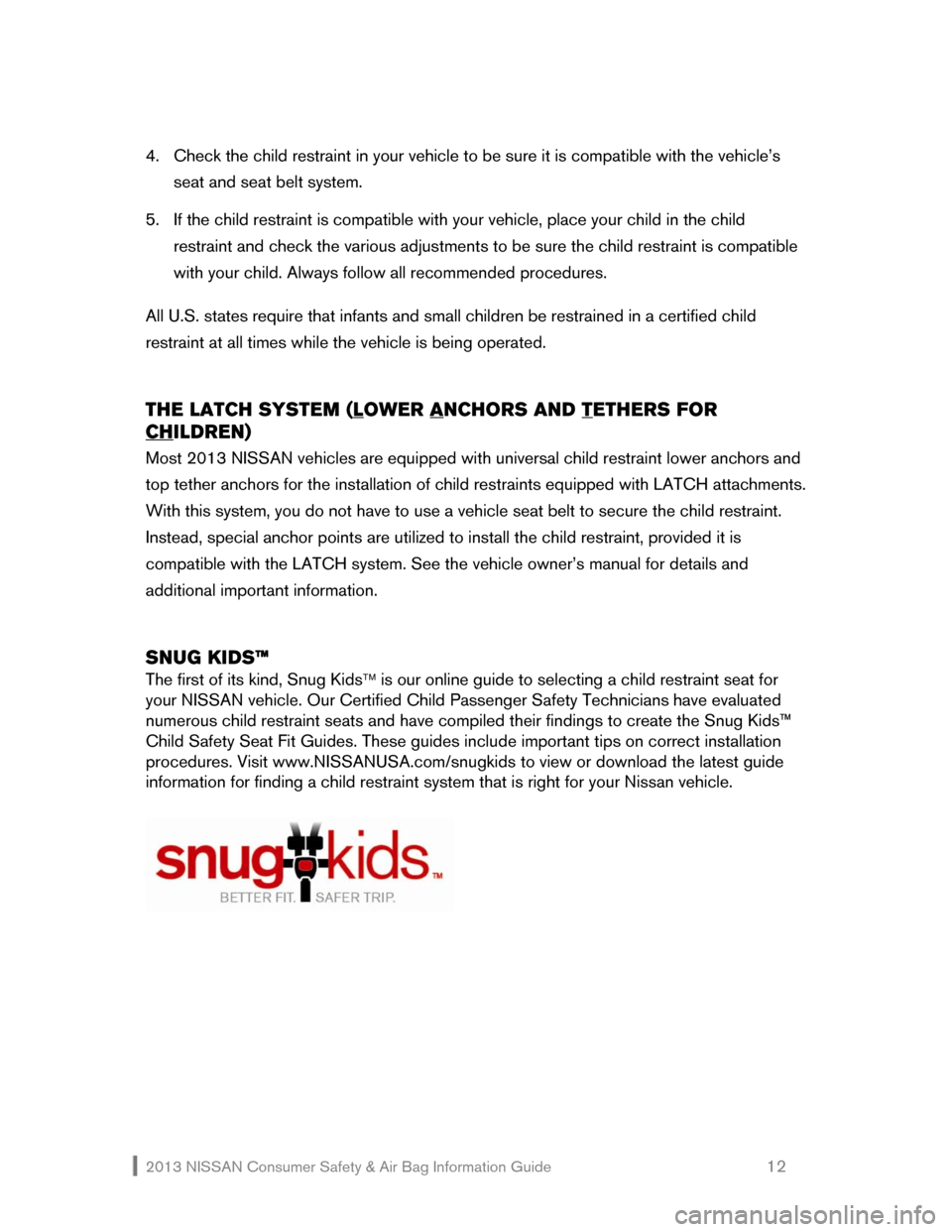
2013 NISSAN Consumer Safety & Air Bag Information Guide 12
4. Check the child restraint in your vehicle to be sure it is compatible with the vehicle’s
seat and seat belt system.
5. If the child restraint is compatible with your vehicle, place your child in the child
restraint and check the various adjustments to be sure the child restraint is compatible
with your child. Always follow all recommended procedures.
All U.S. states require that infants and small children be restrained in a certified child
restraint at all times while the vehicle is being operated.
THE LATCH SYSTEM (LOWER ANCHORS AND TETHERS FOR
CH
ILDREN)
Most 2013 NISSAN vehicles are equipped with universal child restraint lower anchors and
top tether anchors for the installation of child restraints equipped with LATCH attachments.
With this system, you do not have to use a vehicle seat belt to secure the child restraint.
Instead, special anchor points are utilized to install the child restraint, provided it is
compatible with the LATCH system. See the vehicle owner’s manual for details and
additional important information.
SNUG KIDS™
The first of its kind, Snug Kids™ is our online guide to selecting a child restraint seat for
your NISSAN vehicle. Our Certified Child Passenger Safety Technicians
have evaluated
numerous child restraint seats and have compiled their findings to create the Snug Kids™
Child Safety Seat Fit Guides. These guides include important tips on correct installation
procedures. Visit www.NISSANUSA.com/snugkids to view or download the latest guide
information for finding a child restraint system that is right for your Nissan vehicle.